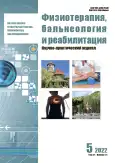The impact of early medical rehabilitation on improving the quality of life of patients after surgical treatment of breast cancer
- Authors: Evstigneeva I.S.1
-
Affiliations:
- Russian Medical Academy of Continuous Professional Education
- Issue: Vol 21, No 5 (2022)
- Pages: 321-330
- Section: Original studies
- URL: https://journals.rcsi.science/1681-3456/article/view/131057
- DOI: https://doi.org/10.17816/rjpbr115246
- ID: 131057
Cite item
Abstract
BACKGROUND: Various methods of physical therapy are widely used in the rehabilitation of patients with oncological diseases. It is known about the successful use of magnetotherapy, various types of electrotherapy, laser therapy, as a result of which the pain, edematous anti-inflammatory syndrome decreases after radical treatment. There are a large number of studies in the literature devoted to the study of the quality of life and the psycho-emotional state of a patient in the process of antitumor treatment, however, there are few studies on the effect of early onset of medical rehabilitation on the quality of life of women after surgical treatment of breast cancer.
AIM: тo compare the effectiveness of prescribing medical rehabilitation in breast cancer patients at different times after surgical treatment of breast cancer 2–4 days and 1–1.5 months after surgery.
MATERIAL AND METODS: A randomized placebo-controlled study was conducted in 70 patients at different times after surgical treatment of breast cancer. All patients underwent medical rehabilitation: individual physical therapy classes, balance therapy, classes with a medical psychologist, general magnetotherapy and intermittent pneumocompression. The main group included 35 patients who were rehabilitated on the 2nd-4th day after surgical treatment of breast cancer, the comparison group included 35 women who were rehabilitated after 1–1.5 months on the background of radiation therapy.
RESULTS: It was proved that the early start of medical rehabilitation in patients after surgical treatment of breast cancer (on the 2nd–4th day), contributed to the rapid restoration of the quality of life, namely, a rapid reduction in pain and postoperative edema, an increase in the volume of movements in the shoulder joint, prevention of severe lymphostasis, rapid restoration of electrical excitability of the shoulder girdle muscles.
CONCLUSION: In the groups, a long-term clinical effect was obtained after the appointment of physiotherapy procedures, which emphasizes the expediency of exposure to physical factors at the first stage of rehabilitation to restore the motor function of the operated upper limb in patients with a history of breast cancer.
Full Text
##article.viewOnOriginalSite##About the authors
Inna S. Evstigneeva
Russian Medical Academy of Continuous Professional Education
Author for correspondence.
Email: evstigneevais@mail.ru
ORCID iD: 0000-0001-9128-0965
SPIN-code: 5163-7726
MD, Cand. Sci. (Med.), Assistant Professor
Russian Federation, MoscowReferences
- The state of oncological care to the population of Russia in 2020. Ed. by A.D. Kaprin, V.V. Starinsky, A.O. Shakhzadova. Moscow; 2021. 239 р. (In Russ).
- Milulescu A, Di Marino L, Peradze N, Toesca A. Management of multifocal-multicentric breast cancer: Current perspective. Chirurgia (Bucur). 2017;112(1):12–17. doi: 10.21614/chirurgia.112.1.12
- Gui Y, Liu X, Chen X, et al. A network meta-analysis of surgical treatment in patients with early breast cancer. J Nat Cancer Institute. 2019;111(9):903–915. doi: 10.1093/jnci/djz105
- Ivanova GE, Buylova TV, Belova LA, et al. Formation of a rehabilitation diagnosis in breast cancer patients at the 1st stage of medical rehabilitation: A clinical case. Bulletin Restorative Med. 2022;21(3):155–174. (In Russ).
- Kochubey AV, Filyuk SA. Analysis of the informative value of dental orthopedic patients' case histories from the standpoint of the international classification of functioning, disability and health (ICF). Kuban Scientific Med Bulletin. 2012;(3):88–91. (In Russ).
- Smith SR, Zheng JY, Silver J, et al. Cancer rehabilitation as an essential component of quality care and survivorship from an international perspective. Disabil Rehabil. 2020;42(1):8–13. doi: 10.1080/09638288.2018.1514662
- Tsai HY, Kuo NC, Chung KP. Quality of life of breast cancer survivors following breast-conserving therapy versus mastectomy: A multicenter study in Taiwan. Jap J Clin Oncology. 2017;47(10):909–918. doi: 10.1093/jjco/hyx099









